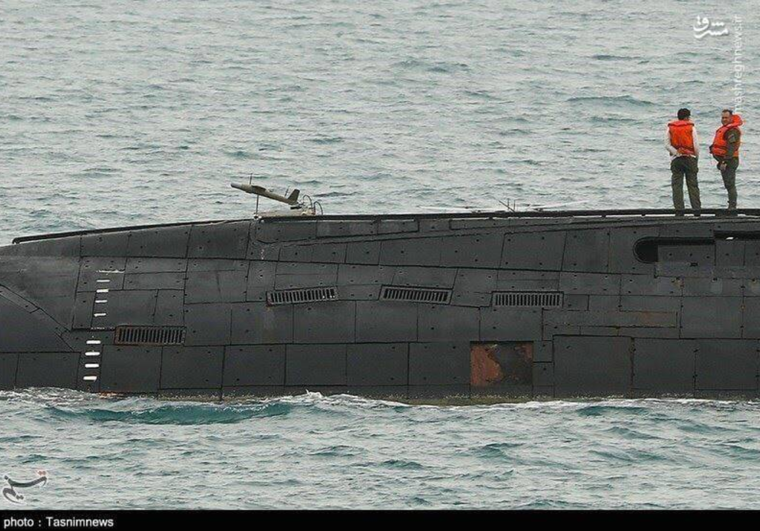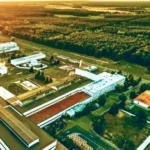„The fact that the Iranians have copied our WB Electronics-made loitering munition is not surprising. However, together with two other experts, we came to interesting conclusions,” writes Łukasz Przybyszewski, President of the Abhaseed Foundation Fund for BiznesAlert.pl.
The rumor that Iran copied the Polish Warmate, which is one of the flagship products of WB Electronics, emerged in the summer of last year, when photos from the maneuvers of Artesh drones, in which as many as 150 of them were used, revealed a new type of a drone. The resemblance to Warmate was striking and immediately apparent. Interestingly these exercises were overseen by Rear Admiral Sajjari, former Commander of the Islamic Republic of Iran Navy and current Coordinating Deputy of the Islamic Republic of Iran Army. The Rear Admiral is an important figure in the structures of Artesh and the Armed Forces of the Islamic Republic in general; he is respected and has a charisma that results in considerable exposure in the media. He is also clearly the person who was appointed as one of the promoters of the modernization of Artesh, which was basically started by the previous Defense Minister, Amir Hatami. It’s an important note. In promoting development and progress, appearances and presentation are also important. And the launch of a copy of the Warmate platform (called Zhubin, which means Javelin / Harpoon / Bolt, because in Polish it is a word with several meanings) from the launchers on board the Fateh-class submarine (Iranian production) and from the deck of the Tarek submarine (Kilo-class) was certainly a curiosity.
„Launching a copy of Warmate from the deck of a surfaced submarine is indeed nonsense. I think it was purely demonstrative,” tells us Fabian Hinz, Research Fellow at the IISS (International Institute for Strategic Studies).
Source: Tasnim News Agency (Zhubin on board the Tarek ship / Kilo-class/)
This means the news about it being a copy based on a Warmate recovered by Russia just a few months ago was false. Most likely, they actually acquired perhaps a newer type, which can actually be reflected in the further development of the copy of the design of WB Electronics. Moreover, there were reports of the acquisition of the FlyEye reconnaissance platform. For now, however, it must be emphasized that the Iranian copy is based on the older Warmate platform.
WB Electronics itself is reticent in its assessment of the new Iranian platform. „( … ) we are not aware of a product that may visually resemble the loitering munition systems supplied by the WB Group to, among others, the Polish Army, other NATO members and the armed forces of other countries. The only source is a few photos on the Internet, and this is not enough to make an analysis,” WB Electronics Communications Department, whose director is Remigiusz Wilk, told us.
„Undoubtedly, as a manufacturer of the Warmate loitering munition, we would like to draw attention to the excellent characteristics of the Polish product, also noted by foreign experts – the optimal choice of dimensions, weight, flight time (loitering) and weight of the warhead (…),” the response from the company continued.
So it was hard to expect that the Iranians would not try to replicate the Warmate. WB Electronics also made it clear on social media that the only way further is to continue improving their products – no use crying over split milk. However, the differences between the Iranian copy and the original are immediately apparent. Even so, WB Electronics sees the Warmate being copied as a success.
„We have lived long enough to see a time when Polish solutions are duplicated by others and „imitation is the highest form of flattery,” as the old saying goes,” according to WB Electronics.
Differences between Warmate and Zhubin
However, there are significant differences between the Iranian version presented to us recently and the Polish original, some visible at first glance, and others, especially concerning the equipment hidden inside, known only to the designers from WB Electronics.
The Communications Department of WB Electronics stressed that „when two solutions are similar, it usually means the original one is more polished and advanced than its alleged copy that was not discussed with the original producer. This concerns both testing the drone as well as its electronic and weapons package. Warmate is a mature product, proven in conditions of high-intensity conflict, ordered in very large numbers (thousands of pieces). In other words, it is a model to which other solutions refer.”
Fabian Hinz, in turn, notes that “ … it is interesting that the Iranians – as far as we can judge from what we see-continue to copy other people’s drones. This contrasts strongly with the ballistic missile programs in which they implement truly their own solutions. Here we see that the radio antenna and GPS are external, while in the Warmate they are hidden. I guess the Iranians only managed to copy the body of the platform.”
Reverse engineering is a tedious, time-consuming and expensive process. It takes years, and the effects are often not worth the money – especially with a product like loitering munition, which is constantly and quickly upgraded. So it is very possible that the Iranian Zhubin will never catch up with the original.
Iran’s drone production targets
For Iran, drones will now become primarily a business and potentially an export hit for a specific target group: although the authorities in Tehran are avoiding selling Shaheds and production lines (it is still not known which ones) to the Russian war machine, they will now be able to offer quite-good-clones of what both sides – Ukrainian and Russian – have in their arsenal. However, it is possible that from a group of Iranian start-ups and other entities constructing drones, some engineers will emerge who will start constructing their own, Iranian models. While many of the UAVs have been copied with varying success (or just well enough), we clearly haven’t seen a true Iranian design yet.
The Iranian drone clientele will probably not be picky: if something is good enough, it will be enough for them. Over time, Iranian engineers may find components that will improve the insides of the Zhubin, at a lower cost. This will certainly lower the price and increase the number of items sold. Either way it will never be the same as Warmate. It doesn’t have to be. Even if the Aresh Navy or the Islamic Revolutionary Guard Corps wanted to use it to intimidate crews on tankers or other vessels (e.g. by hitting the bridge or the devices mounted on its roof), it will definitely suffice. In addition, even if the Zhubin is not at all resistant to electronic warfare means, then what will it matter if the enemy will not have such defences at all (e.g. on one of the theaters of the proxy war), or just in a chosen area? None. Moreover, the U.S. actions in the Middle East over the past two decades, the most recent and still smoldering Azerbaijani-Armenian war, and the current, second Russian-Ukrainian war have clearly shown that drones and loitering munition are the future. A future where Iran can find many customers with shallower pockets.
„What we are seeing now in Iran is a real explosion of entities working on the development of drones. This allows us to see competition and differentiation, but on the other hand, a lot of products will probably have the same, duplicated, operational capabilities, ” says Fabian Hinz.
„There will certainly be no shortage of those willing to test the abilities of the Zhubin. Potential customers may include current users of Iranian models, namely the Iraqi PMU militia, Assad’s army, Hezbollah or the Houthis. If the Zhubin is successful, Tehran could also get a big contract for supplies to Russia. The Palestinians, in particular Hamas, may also be interested in a copy of the Polish loitering munition. Hamas has long been trying to expand its drone fleet. Now that – after several years of cooling-relations between Hamas and Tehran are gradually improving, perhaps Iran will also allow Hamas to get the Zhubin,” notes Tomasz Rydelek, analyst and author of the Puls Levant blog.
Conclusions
Unfortunately, it is not known how and when Iran acquired the Warmate copy or copies. Moreover, we do not know whether it came into possession, or only made copies of the body on the basis of information obtained (from fairs, photos, recordings, from friendly intelligence services). Regardless of all this, it seems highly doubtful that the Warmate was copied after February 24, 2022. In my opinion, this had been done earlier. Perhaps the Iranian services actually somehow obtained the original (or the remains). It is equally likely, however, that they copied only the Warmate body based on general design assumptions.
It is not yet known when mass production of the first generation of the Zhubin will begin, but probably soon enough. It is possible that this will happen within the next year.
It is also worth noting that it may be impossible to identify the funds allocated for the development of he Zhubin and other copies of platforms. Iran’s defense budget was made more classified a few years ago: cryptonyms were introduced for old and new items in the budget law. Some items in the budget, those that are a continuation of previous programs, are traceable. However, this means that new items will be more difficult to assign to specific projects.









